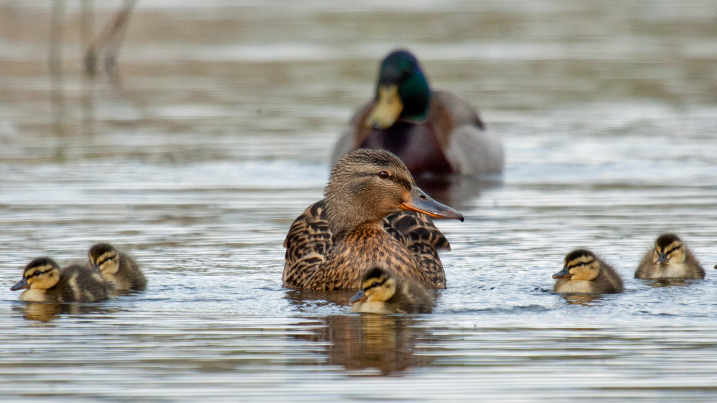When do mallard ducklings appear?
In spring and summer, ducklings abound on rivers and ponds around the UK. Mallards are caring mums, but their task isn’t easy.

Visit a wetland in the spring and it can sometimes feel as though you’re in the way – at least as far as mallards are concerned. Mallard eggs are normally laid anytime between March or July, but they’ve been known to appear much earlier, so you can expect a steady stream of fluffballs throughout the spring and summer period.

The paths seem to need temporary traffic lights to regulate the broods of scampering, fluffy ducklings crossing, one after the other, like the members of an unruly school party. Wander around the trails and ponds and you’re plunged into an atmosphere of business and self-absorption; a loud quack here, a splashing dispute there, the hurrying away of a watchful female. That’s because our most successful wild duck’s breeding season is in full swing.
Mallards can hardly resist the ponds, grassy banks, and quiet areas of scrub and woodland provided on our reserves, especially given the sympathetic management, such as the provision of piles of vegetation and pollarded willows for nests. In the early season, pairs prospect together, the male guarding as the female disappears into the greenery or a hole. Almost as soon as a site is chosen, the female begins the clutch, laying an egg a day for a week or more. Shortly afterwards, the male leaves.

Incubation and rearing take prodigious effort and sacrifice. Once the clutch is complete, the female remains on the nest for nearly 23 hours a day, with two short breaks – usually one before 9am and the other after 4pm. Every half an hour or so, day or night, she shifts position to ensure all eggs are covered. She plucks downy feathers from her breast to create an ‘incubation patch’ to keep the eggs close to her skin at a steady 37.5°C, and sits patiently for some 28 days, forever aware of danger.
Her burden doesn’t reduce when the eggs hatch. Now there are between six and 13 highly mobile ducklings to care for, each capable of running and feeding themselves within a few hours. The female quickly leads them to water; in these first fraught hours she may call 200 times a minute.

Alarm calls summon the brood to regroup, while the female may also distract potential predators with a broken-wing display. Even so, losses are high. It can be 50 more days before the young are self-sufficient, and thankfully the females can lay up to four clutches a year.
Mallard watch: things to spot
Ceremonial flights
Females sometimes test the mettle of their mates by suddenly taking off and expecting the male to follow. Rivals often join these flights of one female and several males.
Loud quacking
If you hear incessant loud quacking from a female in early spring, this might be part of a nest-site assessment. It is thought the calls serve to attract predators, which then betray their presence and allow cautious birds to abandon a ‘high risk’ nest site.
Leading
For various reasons, females don’t always lead their ducklings to the nearest pond. Indeed, they might well change ponds frequently if the mother isn’t satisfied with things. That’s why you so often see parties of ducklings ‘commuting’.

Tight sitting
If you spot a female motionless on the ground, she might be incubating eggs. If she allows a closer approach than seems sensible, then she’s protecting her brood, so please move away quickly and quietly.
Ducklings feeding
Ducklings feed mainly on animal matter at first, including midges, fish eggs and small crustaceans. Look for them jumping up, trying to snap flying insects.

This article was originally published in an edition of WWT’s member’s magazine, Waterlife.
You might also be interested in
What's the best food for ducks?



